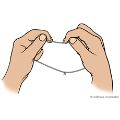Top of the pageActionset
Dental Care: Brushing and Flossing Your Teeth
Introduction
Your teeth can last a lifetime if you practice basic dental care, which involves brushing and flossing regularly, eating a mouth-healthy diet, and visiting your dentist and/or dental hygienist for regular checkups and cleanings. Developing good dental health habits is the best way to prevent tooth decay and gum disease.
How to brush and floss your teeth
When you brush your teeth:
- Brush your teeth 2 times a day, in the morning and at night.
- Use a toothbrush with soft, rounded-end bristles and a head that is small enough to reach all parts of your teeth and mouth. Replace your toothbrush every 3 to 4 months.
- You may also use an electric toothbrush that has the American Dental Association (ADA) seal of approval. Studies show that powered toothbrushes with a rotating and oscillating (back-and-forth) action are more effective than other toothbrushes, including other powered toothbrushes.footnote 1
- Place the brush at a 45-degree angle where the teeth meet the gums. Press firmly, and gently rock the brush back and forth using small circular movements. Do not scrub. Vigorous brushing can make the gums pull away from the teeth and can scratch your tooth enamel.
- Brush all surfaces of the teeth, tongue-side and cheek-side. Pay special attention to the front teeth and all surfaces of the back teeth.
- Brush chewing surfaces vigorously with short back-and-forth strokes.
- Brush your tongue from back to front. Some people put some toothpaste or mouthwash on their toothbrush when they do this. Brushing your tongue helps remove plaque, which can cause bad breath and help bacteria grow. Some toothbrushes now have a specific brush to use for your tongue.
Floss at least once a day. The type of floss you use is not important. Choose the type and flavor you like best. When you floss your teeth, use any of the following methods:
- The finger-wrap method: Cut off a piece of floss 18 in. (45 cm) to 20 in. (50 cm) long. Wrap one end around your left middle finger and the other end around your right middle finger, until your hands are about 2 in. (5 cm) to 3 in. (8 cm) apart.
- The circle method: Use a piece of floss about 12 in. (30 cm) long. Tie the ends together, forming a loop. If the loop is too large, wrap the floss around your fingers to make it smaller.
Gently work the floss between the teeth toward the gums. Curve the floss around each tooth into a U-shape and gently slide it under the gum line. Move the floss firmly up and down several times to scrape off the plaque. Popping the floss in and out between the teeth without scraping will not remove much plaque and can hurt your gums.
A plastic flossing tool makes flossing easier. Child-size flossing tools are available for parents to use to floss their children’s teeth. They are available at most drugstores.
If your gums bleed when you floss, the bleeding should stop as your gums become healthier and tighter next to your teeth.
Credits
Current as of: October 3, 2018
Author: Healthwise Staff
Medical Review:E. Gregory Thompson, MD – Internal Medicine & Adam Husney, MD – Family Medicine & Martin J. Gabica, MD – Family Medicine & Arden G. Christen, DDS, MSD, MA, FACD – Dentistry
Current as of: October 3, 2018
Author: Healthwise Staff
Medical Review:E. Gregory Thompson, MD – Internal Medicine & Adam Husney, MD – Family Medicine & Martin J. Gabica, MD – Family Medicine & Arden G. Christen, DDS, MSD, MA, FACD – Dentistry
This information does not replace the advice of a doctor. Healthwise, Incorporated, disclaims any warranty or liability for your use of this information. Your use of this information means that you agree to the Terms of Use. Learn how we develop our content.







